
Herbs and spices can be used to replace sodium in foods to enhance the flavor. This is important since American’s consume three to four times the recommended amount of sodium daily. According to the Dietary Guidelines for Americans 2015-2020 recommend that Americans consume less than 2,300 milligrams (mg) per day as part of a healthy eating pattern. For those with existing hypertension or pre-hypertension (mildly elevated blood pressure, which often precedes development of hypertension), the recommendation is lowered to less than 1,500 mg of sodium per day; this is the amount of sodium in ¾ of a teaspoon of salt.
HISTORY: Many Gardeners call Basil the “king of the herb.” Basil arrived in the United States in the early 1600’s and was called the “royal herb” by the Ancient Greeks. It originated in Asia, Africa and India then brought to ancient Greece by Alexander the Great. Basil is an indispensable herb from the mint family, originally used medicinally but has been grown since the nineteenth century as a staple of herb gardens and a favorite in culinary uses. The folklore of Basil is as complex as its flavor and aromas.

DESCRIPTION: Basil is described as a tender annual that grows from six inches to thirty-six inches. It has an extraordinary taste including the following: sweet with peppery overtones, minty, spicy and licorice. It is easy to grow and can be started from seeds. It grows best in loose and rich soil in full sun. Plants should be spaced 12 to 18 inches apart when planted in the ground. The flowers are spikes of small white, pink or purple and bloom from mid-summer to fall. Leaves vary in color and ranging in size from small, light green and smooth to large, serrated and dark purple.
TYPES: Basil can be divided into four main groups: sweet green, dwarf green, purple leaved and scented leaf. The most popular types of Basil for culinary uses are: Sweet Basil, Cinnamon Basil, Lemon Basil, Purple Opal Basil and Thai Basil.
- Sweet Basil: is the most common type used for cooking. It has a spicy, mildly peppery flavor with a trace of mint and clove. Sweet Basil accents the flavor of tomatoes.

Lemon Basil Plant - Cinnamon Basil: has green leaves with purple tint, pink and white flowers and an awesome cinnamon flavor and fragrance. Cinnamon Basil is great in apple and most fruit dishes.
- Lemon Basil: has pale dull green leaves and white flowers with a strong lemon fragrance and flavor. Lemon Basil is great with chicken and fish dishes and fruit.

Purple Opal Basil - Purple Opal Basil: has a deep purple and shiny leaf and lavender flowers. It is excellent in vinegar and garnishes. The purple leaf color will turn the vinegar purple in color. Purple leaved Basils are both edible and very ornamental. This type of Basil also has leaf texture that can be ruffled or serrated.

Thai Basil - Thai Basil: has bright green, smooth leaves, white and deep lavender flowers, a strong clove scent and spicy flavor. It is great for stir fry dishes.
Dried vs Fresh: Dried herbs are stronger than fresh cut herbs. Individuals must keep in mind if a recipe calls for dried herbs use two to three times as much fresh herb.
Culinary Uses and Flavor Enhancer: Basil is traditional in Italian, Mediterranean and Thai cooking. Be creative and do not limit your Basil use to only spaghetti sauce, tomato dishes and pesto. Basil is very versatile and can be used in a variety of dishes. Basil is added to soups, stews and sauces at the beginning of cooking, in other dishes add the Basil the last 5 to 10 minutes of cooking time to accent the flavor. All parts of the Basil plant have a culinary use, the flowers can be used as garnishes or cooking. The leaves should be crushed or minced to extract the oils before sprinkling over or rubbing into foods. Stems along with a handful of leaves can be added to coal when grilling the last 10 minutes of cooking. Other herbs that can be used with Basil: garlic, marjoram, mustard, oregano, paprika, parsley, rosemary, sage and thyme. Meats seasoned with basil: roast beef, lamb chops, veal, turkey, fish, shrimp and chicken. Vegetables to accent with basil: tomatoes, peas, eggplant, spinach, zucchini, squash and corn. Desserts, side dishes and beverages enhanced with basil: grilled fruit, fruit salads, pesto, cheeses, ice cream, cakes, potato salads, rice, stuffing, salads, scramble eggs, omelets, teas, and lemonade.
Enhance your flavor palate and spice up your life by using different herbs and spices as flavor enhancers!
For more information contact your local UF/IFAS Extension Office https://sfyl.ifas.ufl.edu/find-your-local-office/ or email Martha Maddox at mmaddox@ufl.edu
 0
0
